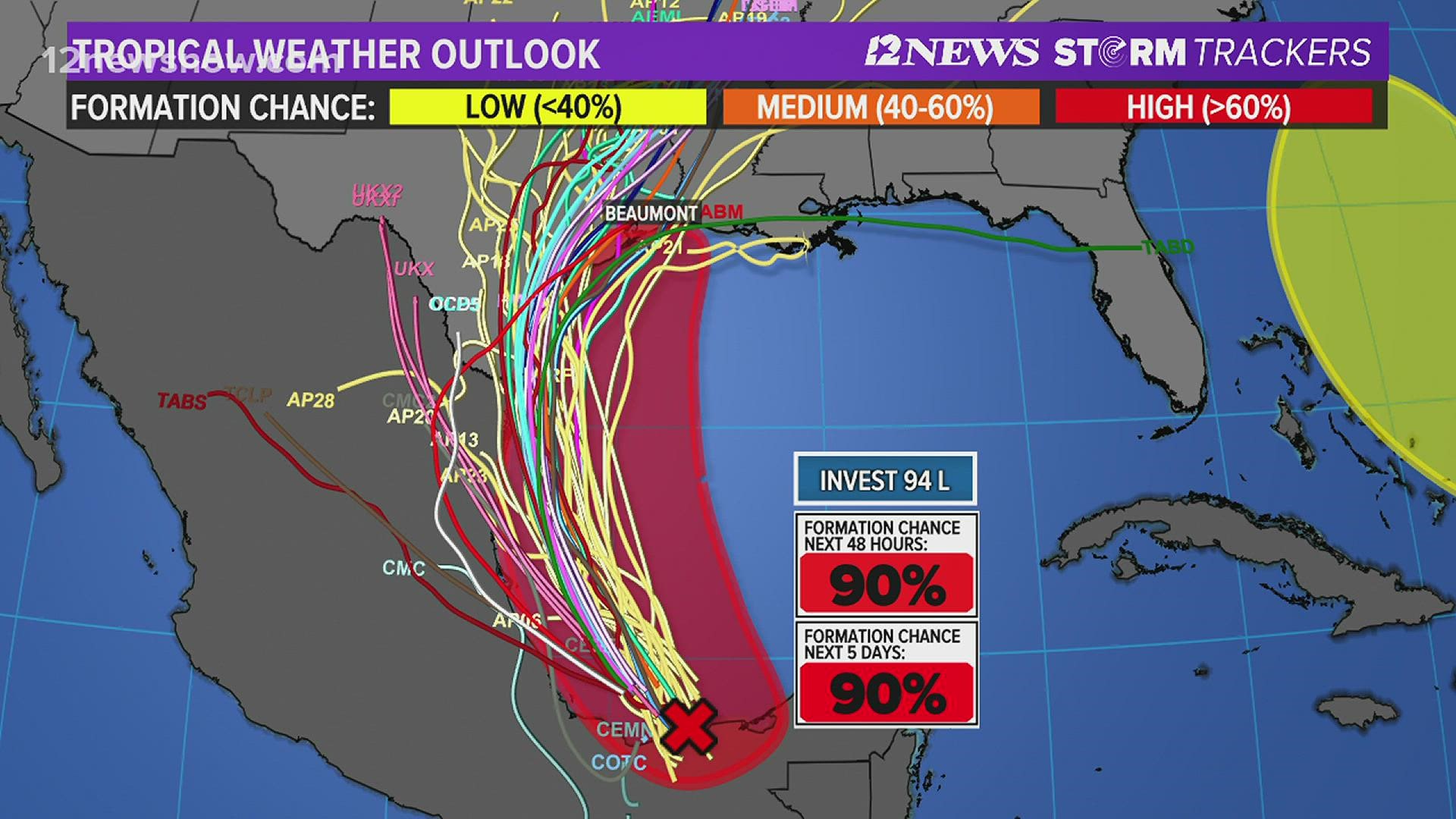BEAUMONT, Texas — (EDITOR'S NOTE: This article is no longer being updated. Here's where to get updates on now-Tropical Storm Nicholas.)
12News' Hurricane Headquarters and the National Hurricane Center are keeping a close eye on the Gulf of Mexico and what is now Potential Tropical Cyclone 14, which still has a high chance of development.
The system could be a big rainmaker for our area, starting Sunday night and lasting for several days.
Right now, winds of PTC 14 are at 35 miles per hour. It's moving to the northwest at 8 miles per hour. The chance of development into a tropical depression or storm within the next 48 hours is now at 90 percent.
Hurricane Hunters are scheduled to fly into the system today, according to the National Hurricane Center’s 7 a.m. update. If a closed center of circulation is found, we'll have either a tropical depression or tropical storm. The next name on the list is Nicholas.
The latest spaghetti models have the system going north/northwest, hugging the coast of Mexico toward southern Texas.

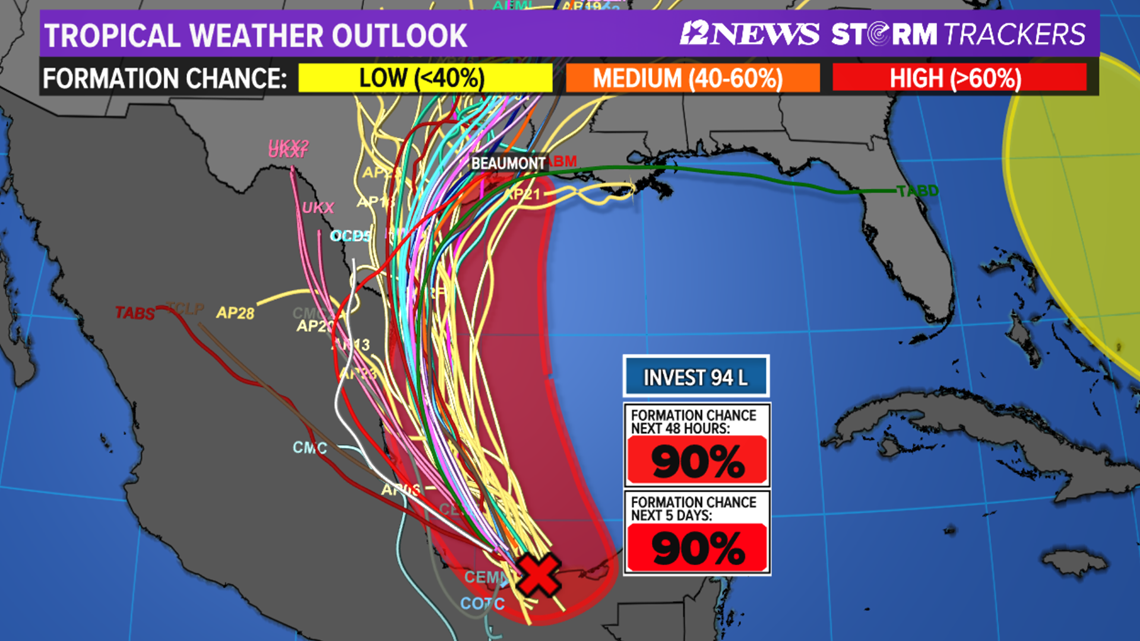

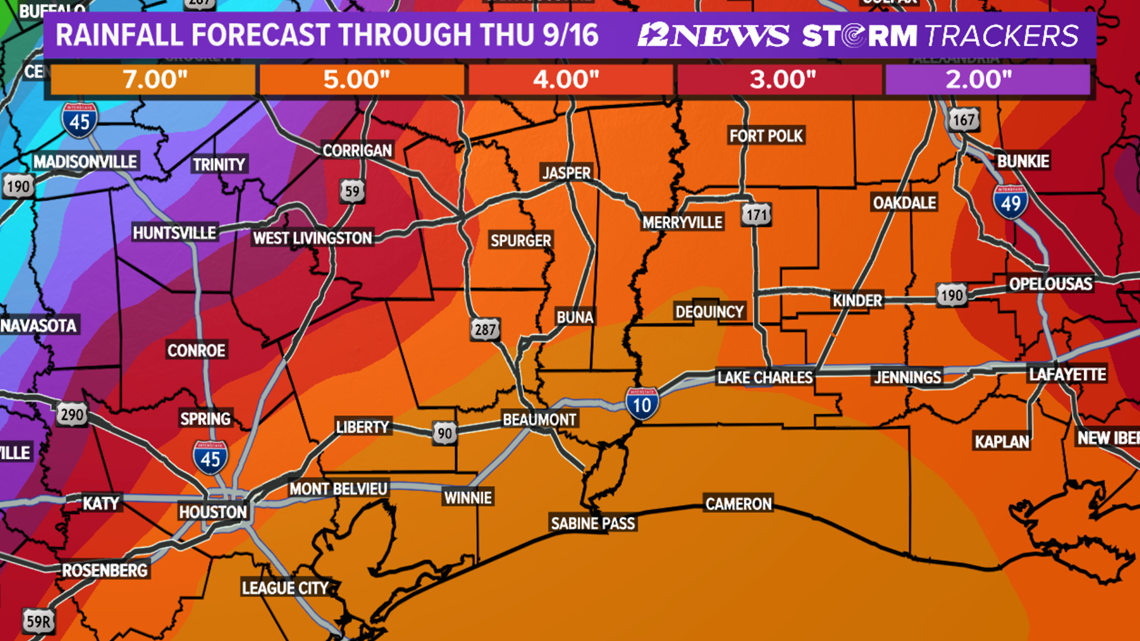
But the two models -- GFS and European models have it taking slightly different tracks. The Euro takes it to our west, which would mean extremely heavy rainfall. The GFS has most of the rain offshore.
Heavy rainfall is the biggest threat. Showers start tonight into tomorrow. Tuesday and Wednesday is when we're likely to see the highest rain chances. If we are going to have a flood threat, Tuesday and Wednesday would be the days.



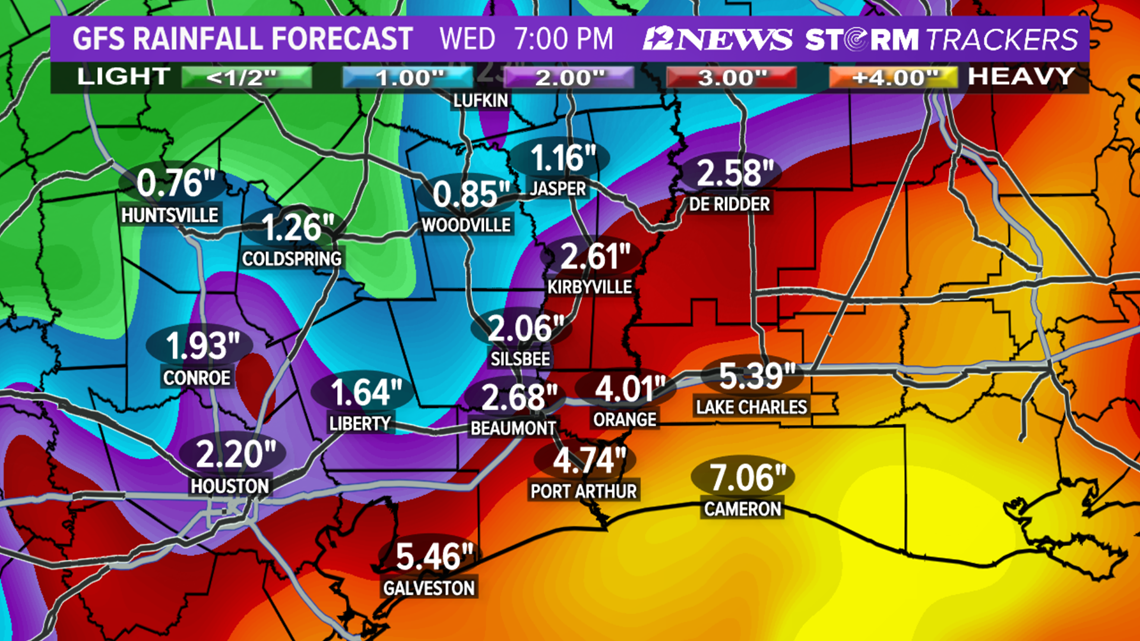
Here's a timeline as things stand now
TODAY: Scattered showers and storms develop this afternoon, mainly to the south, spreading north overnight.
TONIGHT: Scattered showers becoming more widespread into Monday morning. The flood threat is low.
MONDAY MORNING: Periods of rain, moderate to heavy at times, becoming lighter later in the day.
MONDAY AFTERNOON: Scattered showers and downpours, letting up later in the evening.
TUESDAY MORNING: Looks to be a lull in rainfall, scattered lighter showers, as models indicate currently
TUESDAY AFTERNOON: Heavy rain ramps back up, flood risk increasing.
WEDNESDAY MORNING: Very heavy rainfall, flood risk is greater. Rainfall rates of two to three inches per hours are possible
WEDNESDAY AFTERNOON: Heavy downpours. Rainfall rates of two to three inches per hour are possible
THURSDAY MORNING: Heavy rain looks to continue and slowly tapering off to the east through midday.
Whether it gets named or not, the biggest issue with this system will be rainfall. Some spots could see between five and seven inches of rain, with some isolated spots seeing 10 inches or more from Sunday evening to Wednesday morning.
From the National Hurricane Center at 7 a.m. CDT...
Showers and thunderstorms associated with a broad area of low pressure over the southwestern Bay of Campeche have increased overnight and are showing signs of organization.
Environmental conditions are conducive for additional development, and a tropical depression is expected to form later today or tonight while the system moves northwestward and then northward near the coast of northeastern Mexico.
Additional development is possible through the middle of next week if the system remains over water, and interests along the western and northwestern Gulf coast should monitor the progress of this disturbance as watches may be required for portions of the coasts of northeastern Mexico and Texas later this morning or this afternoon.
An Air Force Hurricane Hunter aircraft is currently en route to investigate the system this morning.
Regardless of development, the disturbance will continue to produce heavy rain across portions of southern Mexico today, which may lead to flash flooding and mudslides.
By late today, heavy rain is expected to reach portions of the Texas and Louisiana coasts, with a heavy rain threat continuing across those coastal areas through the middle of the week.
Localized significant rainfall amounts are possible, potentially resulting in areas of flash, urban, and isolated river flooding.
- Formation chance through 48 hours...high...90 percent.
- Formation chance through 5 days...high...90 percent.
RELATED: Texas Cares: Hurricane Ida relief
2021 Hurricane Season Outlook
The 2021 Atlantic Hurricane Season is forecast to produce more storms than average. The reason for this is the lack of El Nino, which typically features more wind shear. We also expect warmer than average sea temperatures and an active West African Monsoon.

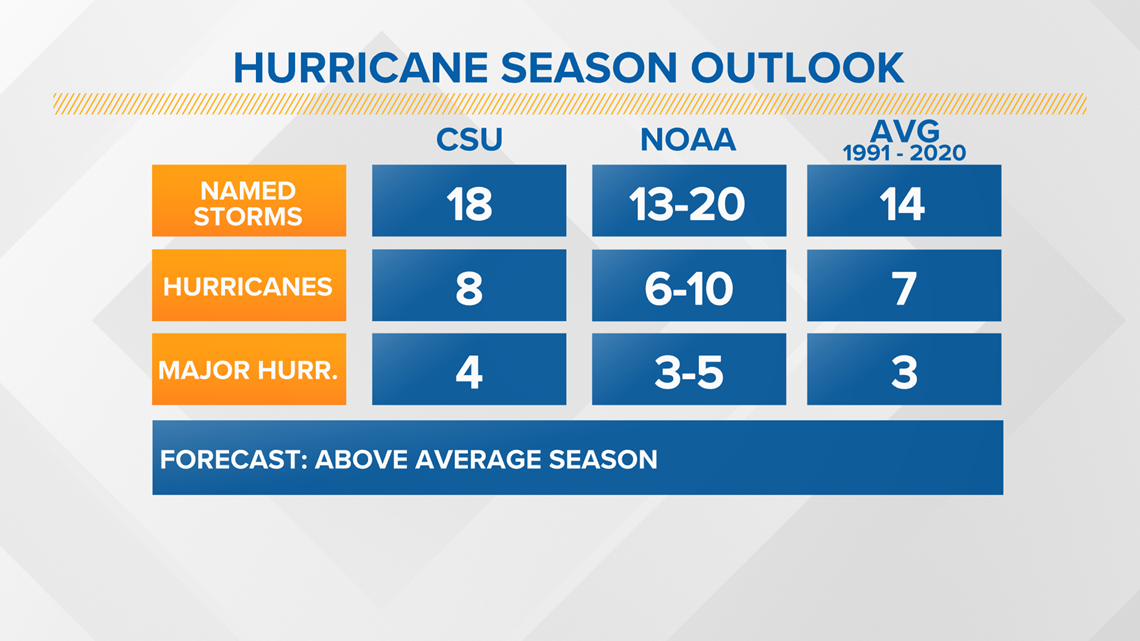
After a record-breaking 2020 hurricane season, we now know the Greek alphabet will no longer be used to name storms.
The World Meteorological Organization announced the Greek alphabet will not be used in the future because it "creates a distraction from the communication of hazard and storm warnings and is potentially confusing."
2021 Atlantic Hurricane Season Names

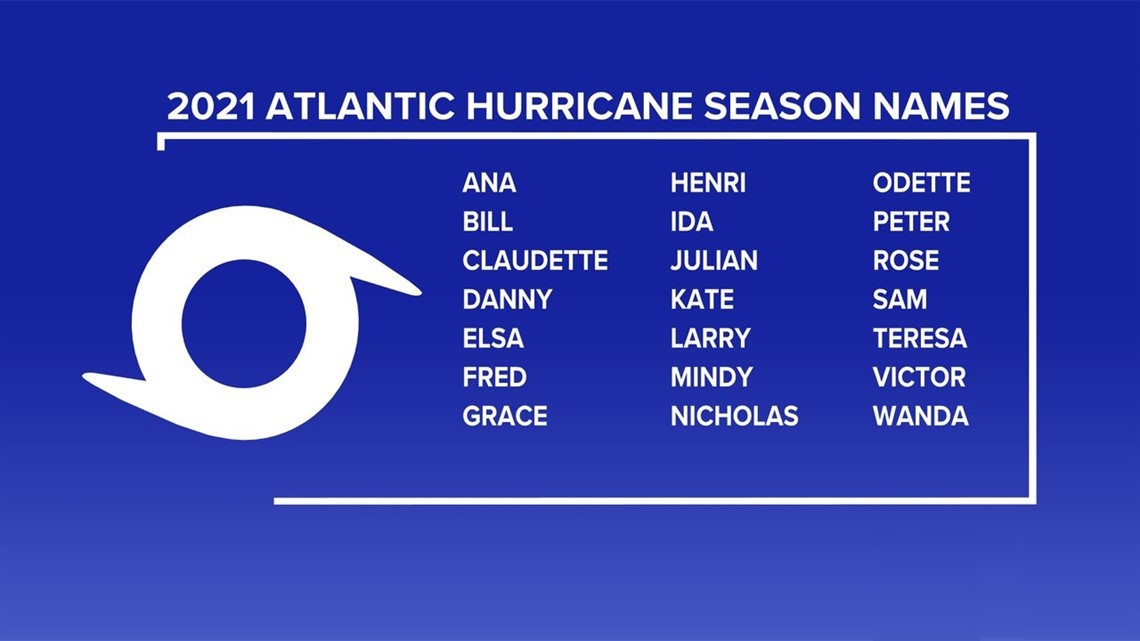
There has been only one other season that used the extra set of names, and that was in 2005. The World Meteorological Organization released a new set of supplemental names that will be used if the season exhausts the standard list.
2021 Atlantic Supplemental Hurricane Names

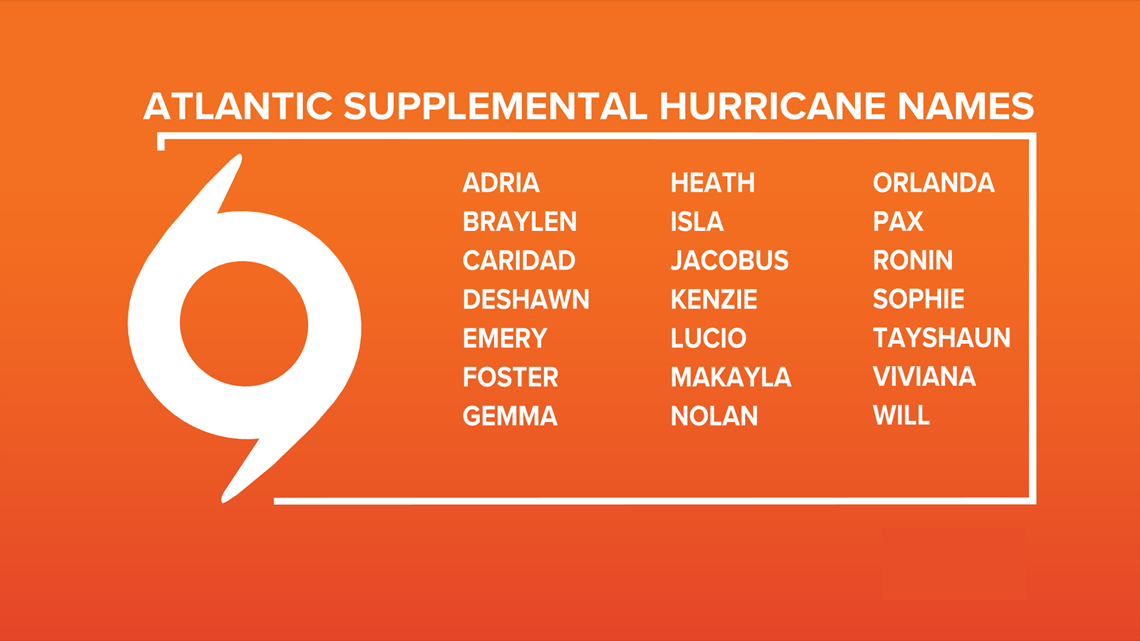
Be prepared if a storm comes our way
BEFORE THE STORM
- Make a home inventory
- Have a current copy of your declarations page that has your policy number and your agent's number
- Review your policy with your insurance agent to determine if you have adequate coverage
- Repair loose boards, shingles, shutters and downspouts to prevent them from becoming an issue in high winds or torrential rain
- Have an evacuation plan, and include plans for your pets
- Make sure your emergency equipment is in working order, including a battery-powered radio, flashlights and extra batteries. Also, make sure to gather all medicine, replenish your first-aid kit and stock a week's worth of non-perishable food and water
- Charge your cell phone and fill your car with gas
- Program all emergency phone numbers
DURING THE STORM
- If you are advised to evacuate, leave as soon as possible. Retain all related receipts - they may be considered in your claim. If you aren't in a recommended evacuation and you plant to stay home, stay informed by listening to weather alerts
- Keep windows and doors closed at all time, and, if possible, board them up with wooden or metal shutters
- Stay away from the windows and in the center of the room, or, stay in an interior room
- Avoid flood water, as it may be electrically charged from downed power lines
- Check on family members and friends
RELATED: Here's how to get severe weather alerts via the 12NewsNow App
AFTER THE STORM
- Check to be sure your family members are safe
- If you did evacuate, wait for official notice that it is safe to re-enter your neighborhood and your house
- Document damaged property, and take photos and videos. Don't dispose of any damaged items without approval
- Keep a record of any temporary repairs or expenses to prevent further damage to your property.
RELATED: Here are some generator safety tips for hurricane season
GET NEWS & WEATHER ALERTS | Download the 12News App to your mobile device

